
Mar 26, 2021 | Articles
For Accredited Investors Only as defined in the Monetary Authority of Singapore Securities and Futures Act (Cap. 289) and its subsidiary legislation. For Professional Investors Only as defined in the Securities and Futures Ordinance (Cap 571, Laws of Hong Kong) and its subsidiary legislation. This advertisement has not been reviewed by the Monetary Authority of Singapore.
Dear Clients,
As we move towards the official launch of our second fund which invests into Japanese hospitality real estate in early April, our Japanese Real Estate team have prepared the first of a three part thought leadership series looking at a key investment asset within our portfolios; Japanese boutique hotels or “Ryokan’s” as they are known in Japan. Over the coming weeks we will explore Ryokan’s and our goal is to help our investors to develop a greater understanding of these traditional and very unique hospitality assets found throughout Japan. Starting with today, and continuing over the coming weeks, our series on Ryokan’s will feature the following topics:
Part One: What are Ryokan’s, how do they operate and what are the key features?
Part Two: Sector Analysis – what are the emerging trends, dynamics and unique selling points of Ryokans?
Part Three: Investment thesis and case study of Ryokans
We hope you find part one interesting and informative first step into understanding the world of Ryokan’s and we look forward to sharing parts two and three soon.
Please click here to access Part One: What are Ryokan’s, how do they operate and what are the key features?
If you like to receive more information, please contact:
James Wheeler
Managing Director – Head of Distribution
james.wheeler@odyssey-grp.com
www.odyssey-grp.com
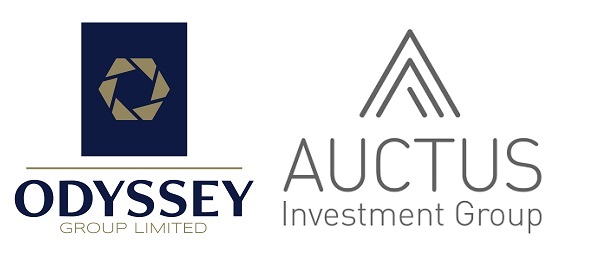
Mar 10, 2021 | Press Releases
For Accredited Investors Only as defined in the Monetary Authority of Singapore Securities and Futures Act (Cap. 289) and its subsidiary legislation. For Professional Investors Only as defined in the Securities and Futures Ordinance (Cap 571, Laws of Hong Kong) and its subsidiary legislation.
KEY POINTS:
- Strategic Partnership with a ASX listed company, Auctus with similar business model
- Auctus to acquire an initial 9.9% stake in Odyssey Group
- Auctus has the option to increase their stake to 100% over the next 2 years subject to regulators’ required approvals
Odyssey Group Limited (‘Odyssey’) is pleased to announce the strategic partnership with Auctus Investment Group Limited (‘Auctus’). Auctus has agreed to an initial investment of US$500K (made out in cash) for a 9.9% stake in Odyssey Group with the option to increase their ownership in the next 2 years subject to regulators’ required approvals. The initial investment will be used for working capital as Odyssey continues to expand its distributions across Asia.
Odyssey Group Limited (‘Odyssey’) was founded in 2016 and is one of Asia’s leading private market asset managers. Odyssey aims to seek out undervalued investment opportunities across multiple asset classes including private real estate, alternative credit and private equity, to co-invest with its clients.
Auctus Investment Group Limited (‘Auctus’) is an ASX listed (AVC:AU) global investment manager with in-excess of A$320M Assets Under Management (AUM), focusing on opportunities across private equity, infrastructure and private real estate. Auctus provides access to these private market investments for wholesale, Family Office and sophisticated investors.

Odyssey Co-Founder and CEO, Alex Walker said “Odyssey has been seeking the right strategic investor for the past 12months and I believe we have found this in Auctus. Both companies share an entrepreneurial mindset and a keen focus on delivering value to our clients. The Odyssey team and I look forward to working with the Auctus team to further tap into the High Net Worth individuals and Family Offices across Asia Pacific region, as well co-investing into attractive investment opportunities that Asia has to offer. It is worth noting, according to UBS, APAC held the highest proportion of ultra-high net worth individuals at 38% with a total net wealth of US$3.3 trillion as compared to 762 (35%) across the Americas and 596 (27%) in Europe, the Middle East and Africa (EMEA). Furthermore, Bain’s Asia Pacific Private Equity Report stated the lack of accessibility of quality private investments in Asia has contributed to unspent capital hitting record highs in 2019”.
Odyssey and Auctus are excited about the partnership due to their similar business models in sourcing undervalued private market investment opportunities and the rising trend of HNW individuals and institutions increasing their asset allocation into private markets in the Asia Pacific region.
The partnership will provide Odyssey with expansionary capital to focus on increasing distribution capabilities and product roll-out across the region. Auctus will gain Odyssey’s AUM of over US$175 million, network, team, and product distribution channels.

Auctus Managing Director, Campbell McComb said “We have high conviction about the outlook of Asian investors’ appetite for private market investments due to limited supply and increasing allocations. We look forward to working with Alex, Dan and the Odyssey team.”
Odyssey Co-Founder and President, Dan Vovil further added “according to PwC’s 2025 Asia-Pacific Report, Asian investors are looking to increase their allocation to private market investments, with growth expected to increase from the market size from US$2.7 trillion in 2017 to US$6.9 trillion in 2025, a CAGR of 11.7%. With this high level of growing demand for private market investment opportunities in Asia and our combined footprint with Auctus, this will provide a superior platform for providing Asian investors access to unique private market products”.
For press enquiries, please contact:
James Wheeler
Managing Director – Head of Distribution
press@odyssey-grp.com
www.odyssey-grp.com
www.auctusinvest.com

Mar 10, 2021 | Articles, Global Markets Update
March 2021 Insight
Inflation is a Dirty Word
If there was one factor that could knock the rally in risk assets on its head is the specter of inflation. That would remove the easy money that has been fueling markets. Right now, it is just the speculation of inflation as indicated by moves in the 5Y treasuries and beyond. Certainly, we have seen some positive inflation in recent data, and that’s a good thing. If we didn’t, it would mean the global economy was not recovering and the markets would have something far worse to contemplate. Indeed, if the recovery accelerates with the distribution of vaccines, headline inflation (CPI) may well surpass the often quoted 2% target in the next couple of quarters term due to low comparisons in Q2 2020 when US CPI fell close to zero. Further, the World Commodity Index has surged 63% since April 2020, which represents large rises in energy and raw material prices.
While headline inflation may cause concern for markets, most governments base monetary policy on some form of core inflation that often excludes food and energy prices. The US Fed favours the Core Personal Consumption Expenditure (PCE) Index as one its measures and this has not been above 2.5% since 1993. Indeed, there has been a falling trend in the PCE over the last 50 years and this unsurprisingly has coincided with the fall in unit labor costs per real GDP. The only time it has sustained above 2% for any length of time in the last 25 years was during the credit bubble of 2004-2008 when it was continually just above 2%. What has been driving this disinflation? My own opinion is that the root cause is accelerating technology adoption and diminishing wage growth due to an ageing working population. In 1999, workers of age 55+ were just 12.7% of the workforce. By 2019 this had almost doubled to 23.4% and by 2029 the U.S. Bureau of Labor Statistics forecast this age group to comprise 25.2% of the workforce.
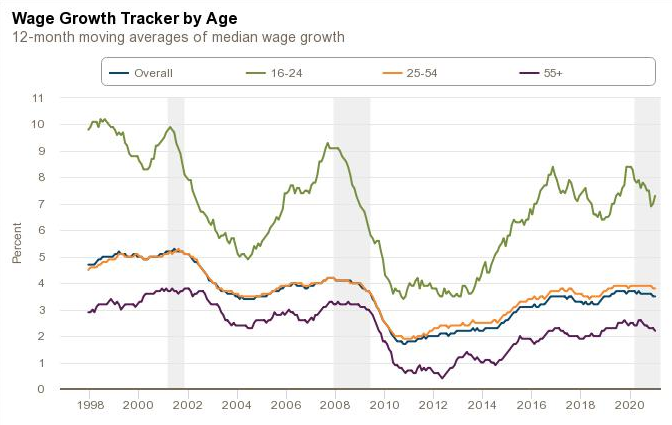
Source: Federal Reserve Bank of Atlanta
Since I am expecting these root forces to continue, it is not expected that the PCE Index to sustain above 2% for an extended time. From the Fed’s dovish comments, we appear to agree. However, the US yield curve is pricing in a rate hike as early as 2023 which is obviously earlier than the Fed’s expectation. Apart from jaw-boning, there is little the Fed can do to affect pricing several years beyond the target rate. The current 2Y-10Y differential is at 1.45%, above the previous spike of 1.34% in December 2016 and close to a potential resistance at 1.5%. Prior to that we had spikes to 1.76% in June 2015 and 2.61% in December 2013. In terms of absolute level of the 10Y UST, the 1.59% yield is similar to that in 2016 and 2012.

Source: Bloomberg
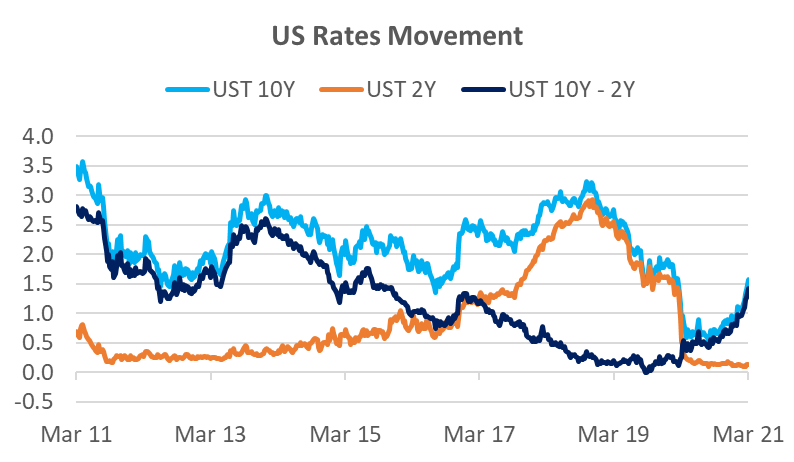
Source: Bloomberg, Odyssey
The Pain Trade in Rates
Several generations of bond traders have made fortunes from being long bonds – making money from when bond yields fall. That is because this has been the trend for three decades. Few traders like to short bonds, because they are betting against the trend. In addition to the specter of inflation, rising bond yields can have significant momentum for a time; everyone is betting in one direction and with significant leverage (often 10x or more). As the bond yields rise and prices fall, it becomes a pain trade for bond traders, and it ends up being a scramble to close out their long positions. The other marginal large player in rates are the large CTA (commodity trading advisors) funds that are followers of directional trends. Commentary suggest they close out their long bond positions in January and started to build up short positions in February. Trend algorithms do not have a human trader’s reticence or care about fundamentals.
Usually when bond yields rise, bond traders have an inkling that either inflation is rising faster than expected or that the government is about to alter monetary policy. In this case, we have only glimpsed the barest evidence of inflation and the Fed has been steadfast in its monetary policy. This is a reason why the bond market and equity investors have been caught a little off-guard, and probably why yields have been higher than what might be expected from fundamentals. Are yields heading even higher? Since the answer appears more technical rather than fundamental, then the short answer is that it is certainly possible.
Dealing with Adjustment Pains
It is not helpful when a market commentator says that the current clearing out in stocks is good for medium and long-term returns when you are losing money. The good news is that blue-chip stocks have been highly resilient. The S&P500 is down less than 3% from its peak and major European burses have hardly moved. In fact, US Value stocks continued to climb another 3% since the S&P500 peak and Banks are up +9%. It’s been the high growth and speculative stocks that have suffered. The Nasdaq has fallen 10% and MSCI China has fallen 16%. Speculative ETFs have fallen 20-30%. In terms of technicals, it’s worth noting that the Nasdaq has hit it’s 100-day moving average. However, the trend of the UST 10Y is likely to remain a major factor.
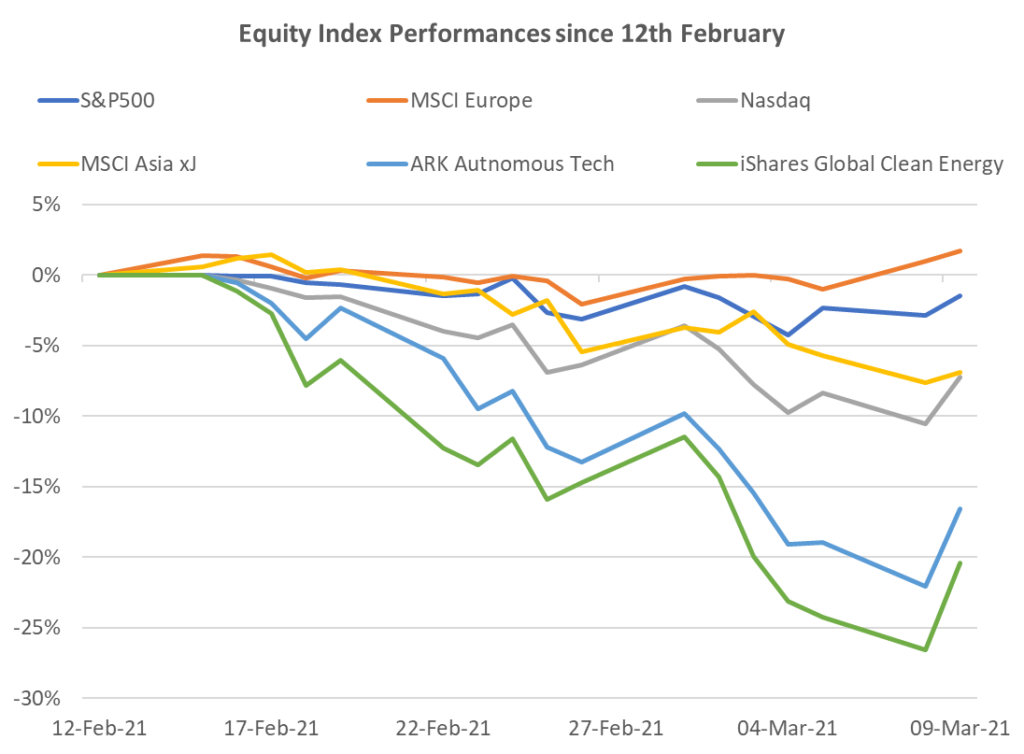
Source: Bloomberg, Odyssey
Mixed Bag in Other Markets
We have been warning about the temptation to buy long duration credit for yield since November last year. The Global Corporate Credit Index is down -4% YTD and US Investment Grade is down -5%. Global HY is largely flat YTD due to lower duration and assisted by a higher carry.
The one asset class that has unequivocally benefitted from the stronger economic outlook has been commodities. The London Metals Index is up +9% YTD, with copper up +14%. WTI Oil is +14% YTD and has moved in virtually a straight line up since the beginning of the year. The main commodity to suffer has been gold which is down -7% YTD and has lost some of its lustre due to the popularity of cryptocurrencies.
Investment Recommendations
When Boring is Good
Back in November 2020 when the Value v Growth issue in stocks first arose, we chose a slightly different tact. We suggested a 3 stock basket that was non-tech and seemed to perform in a steady fashion regardless of whether Value or Growth was favoured. The basket comprised UnitedHealth, Abbott Labs and Morgan Stanley. Since the end of November, the basket is up +14% and up +2% since the recent peak of the SPX500 on February 12. These have not been flashy stocks but together they would have helped to stabilize any equity portfolio and provided significantly better than market returns. All three have announced solid Q4 operational results and we have no qualms about continuing to recommend these stocks, particularly as a basket.
Value in Tech Yet?
Despite the recent 10% fall in the US Infotech sector, the 1-year forward PER at 30x remains 40% higher than the 10-year average at 21x. Some of this is due to the 41% weight to Apple and Microsoft, but there is no denying the sector remains expensive. Nevertheless, the US Infotech sector has hit the 100-day moving average and if we can get some respite from rising rates, the potential for a technical bounce is possible. There are plenty of stocks that we have previously recommended that had very strong Q4 results but have fallen 20-25% to what appears to be technical support levels. These include Paypal, Activision Blizzard, and TSMC to name just three. However, to find one that is trading close to pre-COVID valuations is more difficult.
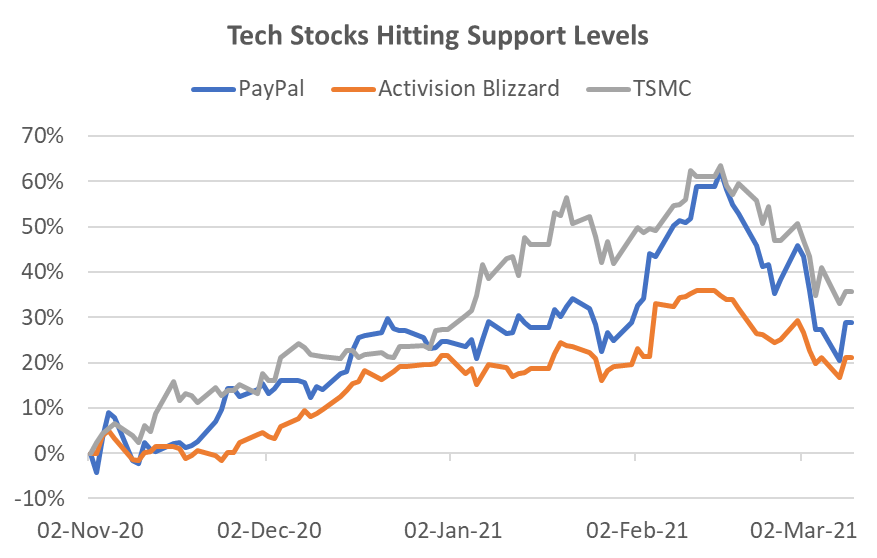
Source: Bloomberg, Odyssey
One such stock is Google. We rarely featured this FAANMG last year because its peers were overshadowing its performance, but the last two quarters have seen a marked operational improvement to firmly catch up with its peers. It has been a major beneficiary of the recovery in online advertising spend, but it is not burdened with as many political and sentiment issues as Facebook. In particular, its Youtube business has been riding a wave of popularity, and with a new product suite, the 45% revenue growth in Q4 2020 is expected to remain strong. Further, while Amazon and Microsoft continue to dominate cloud infrastructure, Google Cloud’s large customer acquisition program has started to improve, demonstrated by 46% revenue growth. Finally, Search remained a very solid performer with 17% revenue growth. At a valuation of 29x 2021 earnings, the stock is trading only slightly high to its usual range of 25-30x over the last 5 years. The stock has shown resilience during the growth sell-off and has only fallen 4% from market peak to trough.
Odyssey Model Portfolio Performance

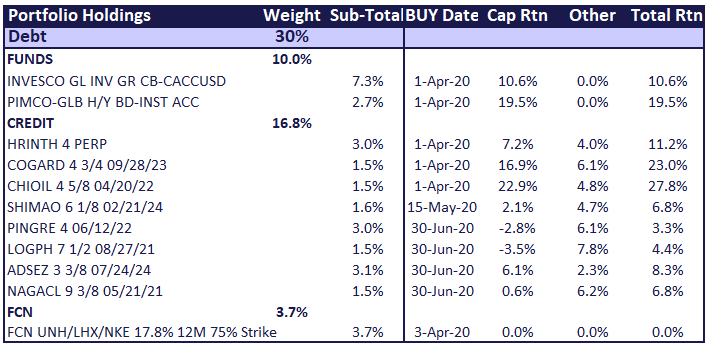
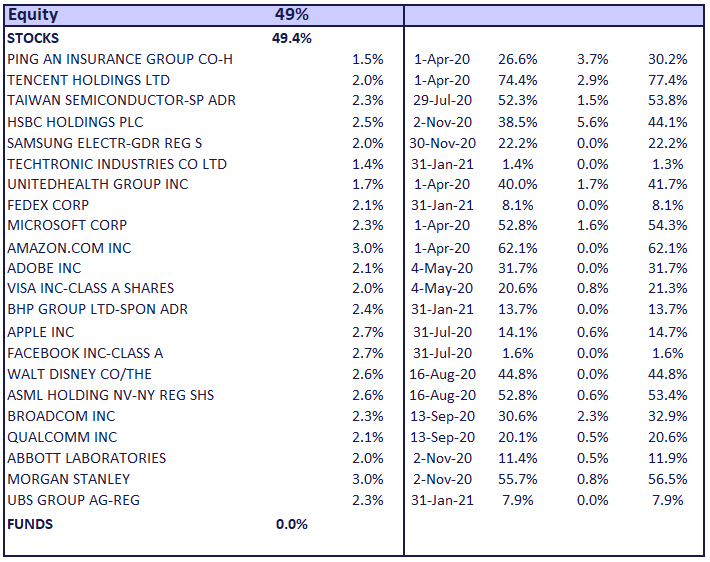

Horizon Performance
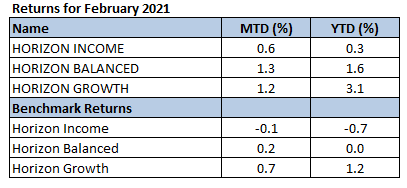
If you like to receive more information on our portfolios solutions, please contact us here: info@odyssey-grp.com.















